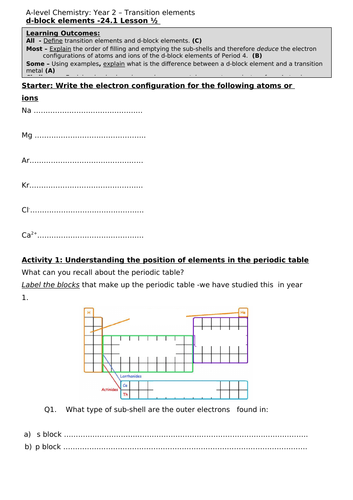




Two Student workbooks and 2 teacher PPs for OCR A Level Chemistry A Year 2 Chapter 24.1 The d block elements and transition elements (Lesson 1) and The properties of transition metals (Lesson 2)
Lesson 1 reviews such key terms as: orbital, sub-shells, energy levels, s, p and d blocks, d -block element, transition element. Next the electronic configuration of atoms and ions of transition metals is discussed. Copper and chromium electronic configuration is explained.
Lesson 2 covers the properties of metals and specific properties of the transition metals caused by incomplete d sub-shell; variable oxidation states, having coloured compounds, acting as catalysts and forming complex ions. Homogeneous and heterogeneous catalysts are discussed.
The workbooks contain lesson objectives , different type of tasks (including challenge tasks and stretch and challenge material) and assessment tasks (self-assessed and exam questions).
The PP for teachers supports the workbook and contains the answers to Tasks in Workbooks. The answers and explanations are revealed in steps.
This resource could present a valuable solution in case when students can not attend the lesson and need to catch up with the missed work.
The resources were prepared with the use of A Level Chemistry for OCR A text book. Some images that appear in student workbook and on PP were taken from this book.
Get this resource as part of a bundle and save up to 37%
A bundle is a package of resources grouped together to teach a particular topic, or a series of lessons, in one place.
Something went wrong, please try again later.
This resource hasn't been reviewed yet
To ensure quality for our reviews, only customers who have purchased this resource can review it
Report this resourceto let us know if it violates our terms and conditions.
Our customer service team will review your report and will be in touch.